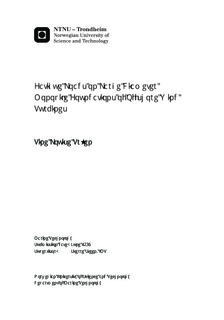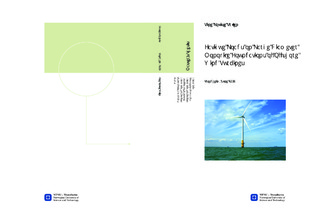| dc.description.abstract | The objective of this master thesis is to investigate the fatigue loading on an offshore wind turbine located in a waterdepth of 45 m. Offshore wind turbines are especially prone to fatigue due to variable environmental loading from wind and waves. The thesis is focused on the effect of misaligned wind and waves and second order wave loading on the fatigue life of the offshore wind turbine. The effect of second order loading is investigated in terms of the resonant phenomena of springing, as the natural frequency of bottom mounted wind turbines are in the frequency range where the second harmonic wave load has its maximum. The damping of the offshore wind turbine is important as the dynamic response of the offshore wind turbine is dependent on the level of damping. In terms of springing and misalignment, the aerodynamic damping is especially important as this is the main source of damping in the fore-aft direction of the offshore wind turbine in operation. Hence, also the aerodynamic damping is investigated to evaluate the results from the simulations in with a reference to the damping of the offshore wind turbine. The overall damping, aerodynamic damping and overall damping in the absence of wind is determined by means of analyses of the free vibrations of the tower top when subjected to a step pulse loading. The overall damping in the absence of wind is determined from an analysis of the decay of the free vibrations of the tower top induced by the step pulse loading and a turbulent wind field. The deterministic part of the response is the part of the response used for calculation of the damping ratio. Simulations with waves coming from angles of 15$\degree$, 30$\degree$, 45$\degree$ and 90$\degree$ relative to the wind direction are performed to investigate the effect of misalignment on the fatigue damage. As a reference load case one simulation with codirectional wind and waves is performed as well. As the aerodynamic damping is reduced for increasing misalignment up to 90$\degree$, an investigation of the effect of springing on the wind turbine is also performed. Hence, the simulations are firstly perfomed with Morison's equation for the computation of wave loads and then with the first two terms of the FNV-method to include second order loading. An investigation of the effect of second order loading in terms of springing is also conducted. For this investigation twelve load cases have been chosen in order to investigate how the response to the second order loading is affected by overall damping, steepness of the waves and the peak period of the wave spectrum. The simulations are performed separately with Morison's equation and the two first terms of the FNV-method. The damping of the offshore wind turbine is found to be in correspondence with the applied damping for the elements of the substructure in the model. As the soil damping applied is very low, an additional simulation with increased damping is performed to investigate the effect of increased damping on the total damping. The increased soil damping does have an effect on the overall damping in the absence of wind, which is increased from 0.75\% to 1.75\%. The aerodynamic and overall damping including the aerodynamic contribution does however not give the expected results as it does not follow the shape of the thrust curve.The second order FNV-method is found to be overconservative for the load cases investigated in this thesis. The mudline moment and the standard deviation of the mudline moment is larger for all load cases, even those that are expected to be dominated by linear loading. The overconservatism is partly due to the constant diameter assumption of the FNV-formulation and its application in this thesis. As the mudline diameter is used for the computation of the wave loads, the resulting load from the first term of the FNV-method is higher than the load computed with Morison's equation which takes the changes of the cross section into account. The effect of misalignment between wind and waves is significant for angles above the 15$\degree$ bin. The largest fatigue damage is seen for the load case with a 90$\degree$ angle of misalignment. Due to the low damping in the side-side direction the response to second order loading, also when taking the overprediction of the FNV-method into account, is larger in this direction than the other ones. Correspondingly the fatigue damage is also larger for this load case for the simulations with the FNV method.The investigation of the effect of springing shows the largest effect of second order loading for the load cases with a peak period that is twice the natural period. The largest effect is found for $H_{S}$ = 2.5 and $U_{hub}$ = 13.9 m/s. However, this simulation is characterised with two peaks in the response spectrum for the combined first and second order wave load, that cannot be explained in terms of the natural ferquencies of the structure. Hence, the results for this load case is biased by these peaks. The second larges effect is found for the same peak period and significant wave heigth and no wind applied. This is in correspondence with the expected response. The conclusive remarks to the investigations performed is that the misalignment of wind and waves does have an impact on the fatigue life of the offshore wind turbine when only the single environmental state is considered. Taking the probabilities of occurrence into account however, the impact becomes smaller. The load case with the largest fatigue damage for the misaligned load cases does in fact not occur, meaning that from a realistic point of view this will not have a significance for the total fatigue life. In addtion the damping of the offshore wind turbine is seen to have an effect in the significance of the second order loading for the total response. This is seen both for the misaligned load cases and the load cases for investigation of springing, as the ratio between the standard deviations computed for the two different wave load models is larger when the damping is low. Finally, a remark to the conservatism in the wave loads computed by the FNV-method is done. As the loads predicted with this method are larger for the linear wave loading as well, the results are more difficult to interpret as the overprediction compared to the results from simulations with Morison's equation must be taken into account when analysing the results. An improvement to the method of invetigation applied in this thesis will be to calculate the wave loading with an equivalen diameter that will give the same linear loading as Morison's equation for the linear wave loads, when using the second order FNV-method. | nb_NO |

